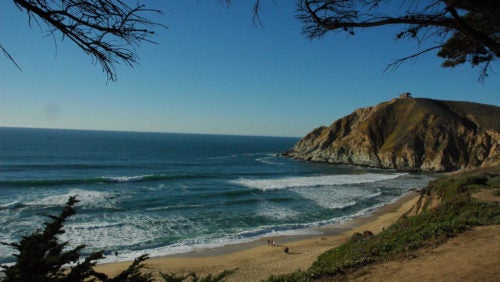(Sea) Walling Off the Beach: The Future of California’s Coastal Commons Remains Contested
November 15, 2018 by Ryan Levandowski

An image of the coast
As rising sea levels threaten California’s coast, the state’s characteristic beaches have become a battleground for homeowners, cities, and state regulatory agencies. Because coastal adaptation policies often pit preservation of public beaches against private property rights, recent litigation over the issue has posed a difficult question for courts: Who should (literally) give ground?
In the wake of extreme storm damage and rising sea levels, factors likely to be exacerbated by climate change,[1] California is facing coastal erosion on a massive scale.[2] A recent report predicts that, with limited human intervention, sea-level rise of one to two meters could completely erode thirty-one to sixty-seven percent of the state’s beaches by 2100.[3] Erosion of this magnitude would also threaten more than $15 billion worth of private homes, jeopardizing hundreds of millions of dollars in property taxes paid to the state.[4] It is clear that California must act, but the policy choices for adaptation to coastal erosion have often forced the state to choose between mitigating damage to public beaches or private property.
In 1976, California’s Coastal Act placed statewide authority over coastal development and management with the Coastal Commission.[5] Since then, the Act has ensured utmost public access and preservation for the state’s beaches, a boon for recreation and economic activity.[6] More recently, the Commission has adopted a strategy of “managed retreat,” or gradual removal of coastal development to allow shorelines to encroach landward naturally, mitigating the effects of sea-level rise on beaches.[7] To this end, the Commission directs cities to consider managed retreat when crafting Local Coastal Plans, and furthermore, may condition the approval of necessary coastal development permits on the surrender of rights to construct and maintain seawalls and other “hardening”[8] countermeasures capable of preventing landward extension of beaches.[9]
Coastal homeowners have pushed back against the Commission’s preference for managed retreat, often claiming that California’s practice runs afoul of state and federal constitutional property rights.[10] Rights guaranteed by California’s Constitution include “acquiring, possessing, and protecting property, and pursuing and obtaining safety, happiness, and privacy,”[11] while the Takings Clause of the U.S. Constitution’s Fifth Amendment, as applied to the States by the Fourteenth Amendment, prohibits the taking of private property for public use without just compensation.[12] However, it is well established that the government may place reasonable conditions on the use of private property, given a significant nexus between the exaction sought and a legitimate state interest.[13] Despite several mounted challenges to Commission actions, courts have yet to definitively decide whether placing specific conditions on seawall construction exceeds this authority.
Last year, the Supreme Court of California declined to reach the constitutional question in Lynch v. California Coastal Commision, regarding a Commission permit that limited a newly constructed residential seawall to a twenty-year term.[14] Although the decision was considered a win for managed retreat in California, it did little to clarify precisely how much the Commission can exact, leaving the door open for future litigation.[15] The constitutional issue has most recently been raised in Beach and Bluff Conservancy v. City of Solana Beach, this time before the California Court of Appeal, Fourth Appellate District, Division One.[16] In a unanimous decision, issued in October, the Court held that a Solana Beach policy refusing to extend seawall construction permits to new coastal developments, adopted at the urging of the Coastal Commission, is at least facially constitutional.[17] However, the issue was not ripe for the Court to decide whether such a policy reaches unconstitutionality “as applied.”[18]
For now, managed retreat has found a foothold in California’s coastal adaptation policies, but the future of the state’s beaches remains uncertain as homeowners and coastal advocates await judicial resolution.
[1] See U.S. Gʟᴏʙ. Cʜᴀɴɢᴇ Rᴇꜱᴇᴀʀᴄʜ Gʀᴘ., Executive Summary, in Cʟɪᴍᴀᴛᴇ Sᴄɪᴇɴᴄᴇ Sᴘᴇᴄɪᴀʟ Rᴇᴘᴏʀᴛ: Fᴏᴜʀᴛʜ Nᴀᴛɪᴏɴᴀʟ Cʟɪᴍᴀᴛᴇ Aꜱꜱᴇꜱꜱᴍᴇɴᴛ, Vᴏʟ. I (D.J. Wuebbles et al. eds., 2017), https://science2017.globalchange.gov/chapter/executive-summary/.
[2] Disappearing Beaches: Modeling Shoreline Change in Southern California, U.S. Gᴇᴏ. Sᴜʀᴠᴇʏ (Mar. 27, 2017), https://www.usgs.gov/news/disappearing-beaches-modeling-shoreline-change-southern-california.
[3] Id.
[4] Higher Tides Will Threaten More than 20,000 California Homes by Mid-Century, Uɴɪᴏɴ ᴏꜰ Cᴏɴᴄᴇʀɴᴇᴅ Sᴄɪᴇɴᴛɪꜱᴛꜱ (June 18, 2018), https://www.ucsusa.org/press/2018/higher-tides-will-threaten-more-20000-california-homes-mid-century#.W9jbdS-ZPRY.
[5] Jᴏʀᴅᴀɴ Dɪᴀᴍᴏɴᴅ ᴇᴛ ᴀʟ., Tʜᴇ Pᴀꜱᴛ, Pʀᴇꜱᴇɴᴛ, ᴀɴᴅ Fᴜᴛᴜʀᴇ ᴏꜰ Cᴀʟɪꜰᴏʀɴɪᴀ’ꜱ Cᴏᴀꜱᴛᴀʟ Aᴄᴛ 5 (Aug. 24, 2017), https://www.law.berkeley.edu/wp-content/uploads/2017/08/Coastal-Act-Issue-Brief.pdf.
[6] Id.
[7] Cᴀʟ. Cᴏᴀꜱᴛᴀʟ Cᴏᴍᴍ’ɴ, Rᴇꜱɪᴅᴇɴᴛɪᴀʟ Aᴅᴀᴘᴛᴀᴛɪᴏɴ Pᴏʟɪᴄʏ Gᴜɪᴅᴀɴᴄᴇ 28 (Mar. 2018), https://documents.coastal.ca.gov/assets/climate/slr/vulnerability/residential/RevisedDraftResidentialAdaptationGuidance.pdf.
[8] Seawalls and similar coastal armors effectively establish a backstop for the beach, allowing sand to gradually wash away until only bedrock is left. See Orrin H. Pilkey and Howard L. Wright III, Seawalls Versus Beaches, 4 J. ᴏꜰ Cᴏᴀꜱᴛᴀʟ Rᴇꜱ. (Sᴘᴇᴄɪᴀʟ Iꜱꜱᴜᴇ) 41, 57 (1988).
[9] See Anne C. Mulkern, California Wrestles with Uncomfortable Option: Retreat, E&E Nᴇᴡꜱ (May 23, 2018), https://www.eenews.net/special_reports/california_crumbling_coast/stories/1060082469.
[10] Deborah Sullivan Brennan, Sea Wall Legal Battles Continue, Sᴀɴ Dɪᴇɢᴏ Uɴɪᴏɴ-Tʀɪʙᴜɴᴇ (July 26, 2017), http://www.sandiegouniontribune.com/communities/north-county/sd-me-seawall-folo-20170728-story.html.
[11] Cᴀʟ. Cᴏɴꜱᴛ. art. I, § 1.
[12] Nollan v. Cal. Coastal Comm’n, 483 U.S. 825, 831–32 (1987).
[13] See id. at 834–37.
[14] Lynch v. California Coastal Commision, 396 P.3d 1085 (Cal. 2017) (holding plaintiffs accepted the permit’s burdens when they initiated construction of the seawall).
[15] Richard Frank, Coastal Commission Prevails in Major California Supreme Court Case, Lᴇɢᴀʟ Pʟᴀɴᴇᴛ (July 6, 2017), http://legal-planet.org/2017/07/06/breaking-news-coastal-commission-prevails-in-major-california-supreme-court-case/.
[16] Beach and Bluff Conservancy v. City of Solana Beach, No. D072304 (Cal. Ct. App. Oct. 17, 2018).
[17] Id., slip op. at 30–32.
[18] Id.

